Wila (lichen)
Wila (Bryoria fremontii) is a dark brown, hair-like lichen that grows hanging from trees in western North America, and northern Europe and Asia. Wila grows abundantly in some areas, and is an important traditional food for many First Nations in North America.
| Wila | |
|---|---|
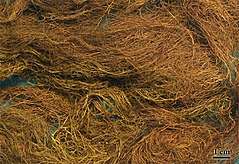 | |
| Scientific classification | |
| Kingdom: | |
| Division: | |
| Class: | |
| Order: | |
| Family: | |
| Genus: | |
| Species: | B. fremontii |
| Binomial name | |
| Bryoria fremontii | |
Name
Wila is currently classified as Bryoria fremontii,[1] although it is often still identified by the outdated classification of Alectoria jubata. Several different English names have been recently invented for wila, including black moss, black tree lichen,[2] and edible horsehair lichen,[3] but none of these names are in common usage. There are traditional names for this lichen in at least 20 different indigenous languages in North America. Wila (wee-la) is the Secwepemctsin name for the lichen, and has been adopted in some publications[4] as an appropriate common name for general use. The Nez Perce name is hóopop and the Sahaptin name is k'ʷɨnč.
Identification
Description
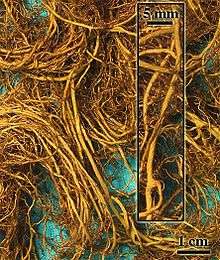
Wila (Bryoria fremontii), like almost all of the 23 other species of Bryoria found in North America, is a dark brown hair lichen that grow on trees (mostly conifers). Differentiating the different species of Bryoria can be difficult. The simplest characteristic that distinguishes wila from the other species of Bryoria is that its main branches grow to be quite thick (greater than 0.4 mm wide), and usually become somewhat flattened, twisted, and wrinkled in older specimens. Other species of Bryoria usually have narrower main branches. Wila can also grow to be a lot longer than other species of Bryoria, and is the only species in this genus in North America that regularly grows longer than 20 cm (occasionally reaching 90 cm in length). Wila is often slightly darker in colour than most other species of Bryoria, although there is much variation in this characteristic. Soredia and apothecia are uncommon, but when they are present they are very distinctive, as they are both bright yellow.
Differentiating poisonous specimens
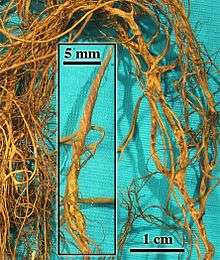
Wila usually does not contain any secondary lichen substances.[1] However, some specimens are quite high in vulpinic acid. These specimens are often classified as a separate species, Bryoria tortuosa; in 1992, it was posited that they are different morphotypes of the same species,[5] but in 2016, it was discovered that the difference is the result of the presence or absence of a basidiomycete as an additional symbiont.[6] Vulpinic acid is both toxic and bright yellow, and, besides making the lichen poisonous, it can also give the lichen a yellowish tint. As a result, although wila is usually reddish-brown to dark brown, some specimens can be yellowish-brown or even bright yellow.
All yellowish specimens of wila should be considered to be poisonous. However, not all poisonous specimens of wila are distinctly yellow. Often the vulpinic acid is concentrated in the interior of each branch, and is not apparent from the colour of the surface of the lichen. A more reliable characteristic to distinguish the poisonous specimens of wila from the edible ones is that the specimens that contain vulpinic acid usually have abundant, long, yellow pseudocyphellae that twist around the main branches (these require a hand lens to see).
Ecology and distribution
Range
Wila is common in the mountainous areas of western North America, being found throughout most of the interior of British Columbia (less common or absent in the northern third of the province), extending east into the Albertan Rockies, and south into Montana, Idaho, and Wyoming, as well as being found in Washington, Oregon, and California.[1] Wila also grows in northern Europe[7] and Russia.[8]
Preferred habitat
In North America, wila is usually found at elevations between 1200 and 2300 m, and rarely as low as 700 m.[1] It grows mainly on conifer trees, although it can be found growing on just about any tree species within its range.
In general, most species of Bryoria prefer drier forests with more open canopies than do the other genera of arboreal hair lichens (like Alectoria, Usnea, and Ramalina). In particular, wila prefers even drier and more open habitats than most other Bryoria species,[5] and within a forest it is most abundant on the trees and parts of trees that are less shaded. As a result, it is particularly abundant on dead and dying trees; on older, defoliated branches of living trees; and higher up on trees.[9]
Ecological importance
Wila can be very abundant in some ecosystems. Researchers have documented up to 3291 kg of arboreal hair lichens (of which wila was a major constituent) per hectare in some areas in the interior of British Columbia.[10] Wila contains small amounts of protein (2.5 – 5% dry weight[11][12]) and significant quantities of the lichen carbohydrate lichenin (15 – 35% dry weight[13][14][15]), which is digestible to some animals. As a result of its abundance and potential nutrition, wila can be very important to the ecology of an area.
Wila (along with many other lichens) is significant food source for a variety of different species of ungulates and rodents.[16] In North America, wila is particularly important for the northern flying squirrel (Glaucomys sabrinus) and the woodland caribou (Rangifer tarandus caribou). The northern flying squirrel eats large quantities of wila, particularly in the winter, when wila is often the only thing that it eats.[17] This squirrel also uses wila to build its nest.[18] During the winter, the woodland caribou in British Columbia[19] and Washington[20] survives almost entirely on arboreal lichens, and wila is one of the species of lichen that it prefers the most.
The ethnolichenology of wila
Importance of wila to humans
The value of wila as a food was often discounted by early European travellers in North America.[21][22][23] However, wila was, and still is, a highly regarded and delicious food for many people,[2][24][25][26][27][28][29][30][31][32] and many First Nations in North America traditionally ate large amounts of this lichen. There are reports that among the Flathead of Montana, even the smallest family would harvest over 10 kg of wila every July.[33]
Range of use
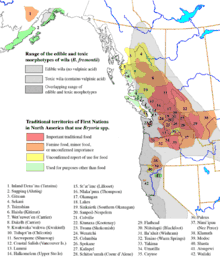
Wila is traditionally eaten by First Peoples throughout most of its range in North America. In the past, this lichen was eaten in large quantities by indigenous peoples in the interior of British Columbia, Washington, and northern Oregon, as well as in parts of Idaho and Montana. Some indigenous peoples in northern California and southern Oregon occasionally used wila for food in times of famine, and the Inland Dena’ina of Alaska traditionally used a different, unidentified species of Bryoria as a famine food. There is no convincing evidence that any coastal people traditionally used wila as food. Currently, wila is not eaten in large quantities, but some people still cook this traditional food as a special treat.
Harvesting wila
Wila is often growing high in trees, and thus can be difficult to harvest. The most common way to collect the lichen is to reach up into the tree with a long stick, twist the lichen around the end of the stick (which is sometimes hooked) and then pull the lichen down off the tree.[34][35] This lichen-collecting stick is called txipmn in the Okanagan language.[34]
Wila can be collected at any time of year, but it is important to choose the right type of lichen. There are numerous other species of Bryoria that look very similar to wila, but that are bitter and mildly toxic. As well, there are some specimens of wila that contain toxic levels of vulpinic acid.[36] Most people that traditionally harvest wila have figured out ways to make sure that they are collecting the right lichen. The species of tree on which the lichen is growing[2][30][37] and the general location of that tree[34][38] are both thought to be important factors for deciding if it is the right type of lichen to eat, but not everyone agrees on which locations and tree species are better. Many people taste the lichen first to make sure that it isn't bitter,[34][39] and some people choose the lichens that are darker coloured.[33]
Processing wila
It is very important that wila is properly cleaned.[21][22][24][31][32][34][35][40][41][42][43] It should first be picked through by hand to remove twigs, dirt, other lichens, sap, and other contaminants. Then it is usually soaked several hours to overnight in water, often in running water. It is sometimes worked with hands, or pounded with a paddle-shaped tool while being soaked. This process of cleaning the wila is called kálka in the Secwepemc language, and likely helps to remove the toxin vulpinic acid, which is slightly water-soluble.[44]
After being cleaned, the wila is traditionally cooked in a pit.[2][21][22][24][25][28][29][30][31][32][33][34][35][37][38][39][42][43][45][46][47][48][49][50][51] The pit is traditionally quite large, 1 to 3 m across and 60 to 90 cm deep. A fire is lit in the pit, and numerous rocks are heated up on the fire until they are very hot. Some people sprinkle some dirt over the rocks after they have been heated up. Then a thick layer of wet vegetation (perhaps moss, fern fronds, skunk cabbage leaves, bark, grass, or conifer needles) is used to cover the rocks and line the pit. The wila is piled on top of this vegetation, almost always with layers of root vegetables or other food. The lichen is then covered with more wet vegetation. Often a barrier of large leaves, bark, reed mats, or burlap sacks is placed on top of all the vegetation to stop any detritus from falling into the food. The entire thing is then covered over with a layer of dirt.
Water is usually added to the pit after it has been covered. This is accomplished by holding a large stick upright in the pit as it is being filled with the dirt, vegetation, and food. This stick is pulled out after the pit is completely covered, leaving a small hole that extends right down to the hot rocks at the bottom. Water is poured down this resulting hole, and then it is sealed with dirt. Then a fire is usually built on top of the pit, and the lichen is left to cook for anywhere from overnight to several days. When it is dug up it has formed a black, gelatinous dough about a quarter of its original volume.
Eating wila
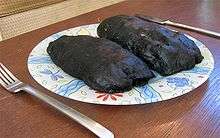
Wila is often eaten freshly cooked. Sugar is often added,[2] and sometimes cream,[32] berries, or fish eggs. If the wila isn't going to be eaten right away, it is dried into cakes and stored for future use. Sometimes berry juice is mixed with the wila before it is dried.[35] These dried cakes can be stored for many years.[24][29][30] Before being eaten, they are usually boiled in water or soup to rehydrate them. Alternately, instead of boiling the cakes, some people just soak the cakes overnight in cold water[34] or dip them into soup like crackers.[34] They can also be powdered and boiled in water to make a porridge.[32]
Other ways to eat wila
It is always preferable to cook wila in a cooking pit. However, it has sometimes been prepared by simply boiling it in water.[25][32][52][53] It is generally reported that this produces an inferior product, and it is likely only done when the chef does not have the time for a proper pitcook.
The Okanagan sometimes roast the fresh lichen on a stick over hot coals, turning it frequently. When the lichen is crumbly it is then boiled to the consistency of molasses. This method of preparation is called spatkán.[34]
Traditionally, the Dakelh usually pitcook wila, but they sometimes use it to bake a kind of fruitcake, The lichen is mixed into the bread dough like one would do with raisins, and it helps the bread to rise when it is baked.[41]
Nowadays, some people occasionally use more modern cooking methods. Several people have reported dissatisfaction with pressure cookers,[2] while others have had more success with crockpots or clay bakers.
Stories about wila
Wila is featured in the stories of several different First Nations. Both the Secwepemc[54] and the Okanagan[29][30] have stories that tell how wila was originally created from Coyote's hair. Wila is also featured in some St’at’imc stories.[55] Some Okanagan people claim that neither men[34] nor menstruating women[56] should come near a pitcook when the lichen is cooking, or it will turn out badly, and there is a Nlaka’pmx belief that a bereaved spouse should not eat lichen cake for a full year after the death of their partner.[25]
In an Okanagan story[29] Coyote tries to catch some swans, but they fool him by playing dead. Not realizing that the swans are just faking, Coyote unwittingly ties them to his son and crawls up a pine tree to get a pitch top for kindling. The swans then flew away with his son, and in Coyote’s haste to get down to save him his long hair got caught in the tree. The swans drop Coyote’s son to his death, and Coyote has to cut off his hair to get free. Coyote then transformed his hair into wila, and pronounces that his valuable hair should not be wasted, rather it should be gathered by the people, and the old women should make it into food.
There is also a similar Secwepemc story.[54] In this account, Coyote is marveling at how easy Spider can go up and down his web. Coyote is so impressed that he tries to copy Spider. Coyote climbs up a tree, and then tries to use his fur as a web to slide down. Of course it doesn't work, and coyote gets stuck. Luckily, Spider comes along and frees Coyote. Some of Coyote's fur is left on the tree, and Spider proclaims that when the people come to live on the land, the fur will be wila, and the people will gather it for food.
Other uses for wila
Wila is also used as a medicine by a variety of First Peoples across North America. Other species of Bryoria are undoubtedly used along with wila for many of these medicinal purposes. The Okanagan (British Columbia) use the lichen for baby medicines,[34][49] and the Nlaka’pmx (British Columbia) use it for removing warts.[25] The Atsugewi (California) use wila as a poultice for swellings,[57] and the Secwepemc (British Columbia) use it for broken bones and for bandages.[2] The Sugpiaq (Alaska) also use it for bandages, and as a hot compress in medicinal steam baths.[58] The Nimi'ipuu (Montana) use wila for digestive troubles,[32] and the Flathead (Montana) as a general tonic.[33] Some Plateau Indian tribes used wila to treat arthritis.[59]
Wila can also be used as a pigment. It produces a green dye when boiled in water, which is anomalous from most of the other species of Bryoria, which all produce yellow-brown to brown dyes.[60] The Haisla (British Columbia) use different species of Bryoria to make a black paint,[61] and the Lummi use them to make a dark green dye.[62]
Several different First Peoples in British Columbia (including the St'at'imc[63] and the Nlaka'pmx[25]) traditionally made clothing out of wila. Lichen garments were usually only worn by poorer people,[25] as they quickly absorb water and are unsuitable in wet weather.[2] The garments were made by twisting together ropes of wila, and weaving them together with plant fibre to form vests, ponchos, shoes, and leggings.[64]
Several other minor uses for wila and other Bryoria species take advantage of their fibrous properties. Various First Peoples in British Columbia traditionally mixed these lichens with mud for chinking cracks in houses, as well as using them as liners for moccasins and diapers, and as a predecessor to paper towels for a variety of domestic purposes.[35]
Dangers
There are numerous other species of Bryoria that can be mistaken for wila, as they all look superficially similar. Although wila is edible, most of the other species of Bryoria are mildly toxic and should not be eaten in large quantities. Furthermore, in certain areas wila can contain toxic quantities of vulpinic acid, which is one of the most potent poisons found in lichens. If you intend to eat wila, you must take proper care to ensure that you are collecting the right species, and that it is not a morphotype that is high in vulpinic acid.
See also
References
- Brodo, I. M. and D. L. Hawksworth. 1977. Alectoria and allied genera in North America. Opera Botanica 42: 1-164.
- Turner, N. J. 1977. Economic importance of black tree lichen (Bryoria fremontii) to the Indians of western North America. Economic Botany 31: 461-470.
- Brodo, I. M., S. D. Sharnoff and S. Sharnoff. 2001. Lichens of North America. New Haven, Yale University Press.
- Crawford, S. 2007. Ethnolichenology of Bryoria fremontii: Wisdon of elders, population evology, and nutritional chemistry. M.Sc. thesis, Interdisciplinary Studies: University of Victoria, Victoria, British Columbia, Canada.
- Goward, T. and T. Ahti. 1992. Macrolichens and their zonal distribution in Wells Gray Provincial Park and its vicinity, British Columbia. Annales Botanici Fennici 147: 1-60.
- Lichens aren't quite what we thought, shocked scientists discover, by Emily Chung, at CBC.ca; published July 21, 2016; retrieved December 30, 2016
- Motyka, J. 1962. Porosty (Lichenes). Flora Polska, Tom. V, Czesc II. Polska Akademia Nauk. Instytut Botaniki. Warszawa: 1-151.
- Kravchenko, A. V. 2003. Records of the protected species Bryoria fremontii (Parmeliaceae, Ascomycotina) in Arkhangelsk and Vologda regions. Botanicheskii Zhurnal 88(2): 102-104.
- Goward, T. 1998. Observations on the ecology of the lichen genus Bryoria in high elevation conifer forests. Canadian Field-Naturalist 112(3): 496-501.
- Edwards, R. Y., J. Soos and R. W. Ritcey. 1960. Quantitative observations on epidendric lichens used as food by caribou. Ecology 41(3): 425-431.
- Fujikawa, F., K. Hirai, T. Hirayama, T. Toyota, T. Nakamura, T. Nishimaki, T. Yoshikawa, S. Yasuda, S. Nishio, K. Kojitani, T. Nakai, T. Ando, Y. Tsuji, K. Tomisaki, M. Watanabe, M. Fujisawa, M. Nagai, M. Koyama, N. Matsuami, M. Urasaki and M. Takagawa. 1970. On the free amino acids in lichens of Japan. I. Yakugaku Zasshi 90: 1267-1274.
- Pulliainen, E. 1971. Nutritive values of some lichens used as food by reindeer in north-eastern Lapland. Annales Zoologici Fennici 8: 385-389.
- Yanovsky, E. and R. M. Kingsbury. 1938. Analyses of some Indian food plants. Association of Official Agricultural Chemists 21(4): 648-665.
- Common, R. S. 1991. The distribution and taxonomic significance of lichenan and isolichenan in the Parmeliaceae (lichenized Ascomycotina), as determined by iodine reactions.1. Introduction and methods.2. The genus Alectoria and associated taxa. Mycotaxon 41(1): 67-112.
- Kirkpatrick, R. C., R. J. Zou, E. S. Dierenfeld and H. W. Zhou. 2001. Digestion of selected foods by Yunnan snub-nosed monkey Rhinopithecus bieti (Colobinae). American Journal of Physical Anthropology 114(2): 156-162.
- Sharnoff, S. 1994. Use of lichens by wildlife in North America. Research & Exploration 10(3): 370-371.
- Rosentreter, R., G. D. Hayward and M. WicklowHoward. 1997. Northern flying squirrel seasonal food habits in the interior conifer forests of central Idaho, USA. Northwest Science 71(2): 97-102.
- Hayward, G. D. and R. Rosentreter. 1994. Lichens as nesting material for northern flying squirrels in the northern Rocky Mountains. Journal of Mammalogy 75(3): 663-673.
- Kinley, T. A., J. Bergenske, J. A. Davies and D. Quinn. 2003. Characteristics of early-winter caribou, Rangifer tarandus caribou, feeding sites in the southern Purcell Mountains, British Columbia. Canadian Field-Naturalist 117(3): 352-359.
- Rominger, E. M., C. T. Robbins and M. A. Evans. 1996. Winter foraging ecology of woodland caribou in north-eastern Washington. Journal of Wildlife Management 60(4): 719-728.
- Wilkes, C. 1845. Narrative of the United States Exploring Expedition. During the years 1838, 1839, 1840, 1841, 1842. Vol IV.. Philadelphia, Lea and Blanchard.
- de Smet, P. J. 1847. Oregon missions and travels over the Rocky Mountains in 1845-46. New York.
- Blankinship, J. W. 1905. The native economic plants of Montana. Bulletin - Montana State College, Agricultural Experiment Station 56: 1-38.
- Dawson, G. M. 1891. Notes on the Shuswap People of British Columbia. Transactions of the Royal Society of Canada, Section 2 Part I: 3-44.
- Teit, J. A. and F. Boas. 1900. The Thompson Indians of British Columbia. American Museum of Natural History Memoir No. 2.
- Teit, J. A. 1906. The Lillooet Indians. American Museum of Natural History Memoir No. 4, New York, NY.
- Teit, J. A. 1909. The Shuswap. American Museum of Natural History Memoir No. 5. New York, NY.
- Teit, J. A. and F. Boas. 1928. The Salishan tribes of the western plateaus. Forty-Fifth Annual Report of the Bureau of American Ethnology to the Secretary of the Smithsonian Institution, 1927-1928 45: 23-296.
- Mourning Dove. 1933. How Coyote happened to make the black moss food. Coyote Stories. Caldwell, Idaho, Caxton Printers, Ltd.: 119-125.
- Spier, L., W. B. Cline, R. S. Commons and M. Mandelbaum. 1938. The Sinkaietk or Southern Okanagon of Washington Contributions from the Laboratory of Anthropology, 2. General Series in Anthropology, No. 6. Menasha, Wisconsin, George Banta Publishing Co.
- Stubbs, R. D. 1966. An investigation of the edible and medicinal plants used by the Flathead Indians. M.A. thesis, University of Montana, Missoula, Montana.
- Hart, J. 1976. Montana - Native plants and early peoples. Helena, Montana, The Montana Historical Society and The Montana Bicentennial Administration.
- Turney-High, H. H. 1937. The Flathead Indians of Montana. Memoirs of the American Anthropological Association No. 48.
- Turner, N. J., R. Bouchard and D. I. D. Kennedy. 1980. Ethnobotany of the Okanagan-Colville Indians of British Columbia and Washington. Occasional Papers of the British Provincial Museum 21: 1-179.
- Turner, N. J., L. C. Thompson, M. T. Thompson and A. Z. York. 1990. Thompson Ethnobotany: Knowledge and Usage of Plants by the Thompson Indians of British Columbia. Victoria, British Columbia, Royal British Columbia Museum.
- Stephenson, N. L. and P. W. Rundel. 1979. Quantitative variation and the ecological role of vulpinic acid and atranorin in the thallus of Letharia vulpina. Biochemical Systematics and Ecology 7: 263-267.
- Ray, V. F. 1932. The Sanpoil and Nespelem: Salishan peoples of north-eastern Washington. University of Washington Publications in Anthropology 5.
- Marshall, A. G. 1977. Nez Perce Social Groups: An Ecological Interpretation. Ph.D. thesis, Department of Anthropology: Washington State University, Pullman, Washington, USA.
- Palmer, G. 1975. Shuswap Indian Ethnobotany. Syesis 8: 29-81.
- Thompson, D. 1784-1812. David Thompson's narrative of his explorations in western America, 1784-1812. Prepared for publication by J. B. Tyrrell in 1916. Toronto, Champlain Society.
- Morice, R. A. G. 1894. Notes archaeological, industrial, and sociological on the western Dénés with on ethnographical sketch of the same. Transactions of the Canadian Institute 4(7).
- Douglas, D. 1914. Journal kept by David Douglas during his travels in North America 1823-1827, together with a particular description of thirty-three species of American oaks and eighteen species of Pinus, with appendices containing a list of the plants introduced by Douglas and an account of his death in 1834. Published under the direction of the Royal Horticultural Society. Edited by W. Wilks and H. R. Hutchinson.. Toronto, Champlain Society.
- Spier, L. and E. Sapir. 1930. Wishram ethnography. University of Washington Publications in Anthropology 3(3): 151-300.
- Lauterwein, M., M. Oethinger, K. Belsner, T. Peters and R. Marre. 1995. In vitro activities of the lichen secondary metabolites vulpinic acid, (+)-usnic acid, and (-)-usnic acid against aerobic and anaerobic micro-organisms. Antimicrobial Agents and Chemotherapy 39(11): 2541-2543.
- Harmon, D. W. 1800-1816. A Journal of Voyages and Travels in the Interior of North America Between the 47th and 58th Degrees of North Latitude, Extending from Montreal Nearly to the Pacific, a Distance of About 5,000 Miles, Including an Account of the Principal Occurrences During a Residence of Nineteen Years in Different Parts of the Country. Toronto, Courier Press, Limited (1911).
- Morse, J. 1822. A Report to the Secretary of War of the United States, on Indian Affairs, Comprising a Narrative of a Tour Performed in the Summer of 1820, Under a Commission from the President of the United States, for the Purposes of Ascertaining, for the Use of the Government, the Actual State of the Indian Tribes in Our Country. Washington, D. C., Davis & Force.
- Parry, C. C. 1871. Food products of the North American Indians. Report of the U. S. Commissioner of Agriculture for the year 1870 [Washington](8): 404-428.
- Chamberlain, A. F. 1892. Report on the Kootenay Indians of South-eastern British Columbia. Eighth Report on the North-western Tribes of Canada. British Association for the Advancement of Science, Edinburgh Meeting: 545-615.
- Gabriel, L. and H. E. White. 1954. Food and medicines of the Okanakanes. (Compiled by Hester White). Report of the Okanagan Historical Society of Vernon, British Columbia 18: 24-29.
- Keddie, G. 1988. The Kootenay lichen pounder. The Midden 20(1): 6-9.
- Turner, N. J. and A. Davis. 1993. "When everything was scarce": The role of plants as famine foods in north-western North America. Journal of Ethnobiology 13(2): 171-201.
- Lewis, M. and W. Clark. 1804-1806. Original Journals of the Lewis and Clark Expedition. New York, Antiquarian Press Ltd.
- Spinden, H. J. 1907-1915. The Nez Perce Indians. Memoirs of the American Anthropological Association 2: 165-274.
- Bouchard, R. and D. I. D. Kennedy. 1979. Shuswap stories: Collected 1971-1975. Vancouver, BC, CommCept.
- Bouchard, R. and D. I. D. Kennedy. 1977. Lillooet Stories. Sound Heritage 4(1): 1-78.
- Elmendorf, W. W. 1935-1936. Lakes Salish Ethnographic Notes. Unpublished Field Notes, original held by Dr. W. W. Elmendorf, Department of Anthropology, The University of Wisconsin, Madison, Wisc. (photoduplicated copy in British Columbia Indian Language Project files, Victoria).
- Garth, T. R. 1953. Atsugewi Ethnobotany. Anthropological Records [University of California Publications] 14(2): 129-212.
- Wennekens, A. J. 1985. Traditional plant usage by Chugach Natives around Prince William Sound and on the Lower Kenai Peninsula, Alaska. M.A. thesis, University of Alaska, Anchorage, Alaska.
- Hunn, Eugene S. (1990). Nch'i-Wana, "The Big River": Mid-Columbia Indians and Their Land. University of Washington Press. p. 352. ISBN 0-295-97119-3.
- Brough, S. G. 1984. Dye characteristics of British Columbia forest lichens. Syesis 17: 81-94.
- Compton, B. D. 1993. Upper North Wakashan and Southern Tsimshian Ethnobotany: The Knowledge and Usage of Plants and Fungi among the Oweekeno, Hanaksiala (Kitlope and Kemano), Haisla (Kitamaat) and Kitasoo Peoples of the Central and North Coasts of British Columbia. Ph.D. thesis, University of British Columbia, Vancouver, British Columbia, Canada.
- Stern, B. J. 1934. The Lummi Indians of Northwest Washington. Columbia University contributions to anthropology. New York, Columbia University Press.
- Turner, N. J. 1998. Plant Technology of First Peoples in British Columbia. Royal British Columbia Museum Handbook. Vancouver, British Columbia, UBC Press.
- Newcombe, C. F. 1901-1913. Unpublished field notes. Provincial Archives of British Columbia, Victoria, BC.